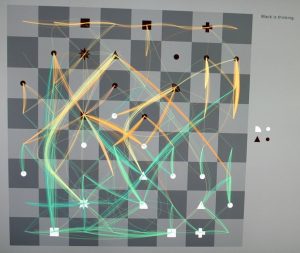In the previous post I described the traps you can fall victim to when studying openings in a superficial and passive way. Such warnings are important, but only half as valuable, if not followed-up by concrete suggestions about how to do it right. Hence, I will present you with a list of actions, which is more or less arranged in chronological order. The advise can be used under the following assumption:
- You possess the ChessBase program.
- You have acquired a big database or work with the online database, which is free of charge and always up to date.
- You work with an engine, be it a commercial one or the open source product Stockfish.
- You know what opening/variation you want to learn. Picking the right line is a completely different ball game and belongs to the topic “opening repertoire”. This post only deals with the technical aspects of learning openings.

1. Creation of the raw tree
Create a “variation tree” (I also name this “analysis” or “super game”) for each line your opponent might play against your chosen opening/variation, by merging all available games. You might not want to overload such a tree and confine it to maybe 25 single games, if possible. Have a look at the structure of your topic and try to find logical separation lines. In the majority of cases there are always good points for decent sub-division.
There are good arguments for filtering the material, for instance by only including games with an average of Elo 2400. That way, you reduce the information you have to process and raise the likelihood of only dealing with moves of decent quality. Personally, I like to have all available information. Bad games are indicated by ratings (of course you don’t take a level of 1500 too seriously) and can be quickly deleted, if so suggested by the engine. On the other hand, I am interested to see the opinion of a 1900 player, as his moves are basically common sense. Well, common sense is not enough for mastery in chess, as we know, but worth spending some time on. After all, understanding a position also happens by learning why something is bad and how it can be refuted.
2. Using external information
Often you have a book on the topic, which might be your reason for learning it in the first place. In this case you can simply adopt the quantitative structure provided by the author for establishing your analyses. For each line or sub-line of the book, you create a respective tree. However, if the book is very superficial, this might not be enough. When working with a book, insert all relevant information, be it symbolic or verbal comments, into your file. You would also adopt the internal hierarchy of the lines within each tree, at least at the beginning.
3. Independent structuring
Without the help of a book, you have to structure the hierarchy of moves yourself. The goal is clear: You want to establish the best moves for both sides as the main line. A good start is using the function “reorder variations”, which will create a long an lean tree without big bulges, by allocating the majority of the games towards the end of the tree. This quantitative procedure often coincides with your qualitative goal, as the majority tends to seek quality and follows the main line. Following the majority, however, does not always work. This would be too easy. What you also want to look out for are recent games of strong masters. Even more important than this are correspondent games. A recent remote game (i.e. backed by a strong engine) of a 2200 player will often be worth more than one of a 2600 OTB player.
4. Conceptual examination
After the initial structuring, you should get acquainted with the games. Play through them and make observations. Make verbal notes when finding interesting manoeuvres, plans or tactical motifs. Of highest value are recurring patterns, as they indicate that what you see is not arbitrary, but belongs to the inner architecture of the position type. Such high-quality patterns are replicable in a systematic manner. Your intention should be to understand the logic of the position, which includes the dominant concepts, the strategic goals of both parties and the typical winning ideas.

A chess program in the act of thinking
5. Analysis
Finetune your material with the help of your engine, by analyzing critical positions. The previous conceptual examination helps you to identify these. Of course, your engine is more powerful on a good hardware, which will allow you to work with a search depth of 30 plies (half moves). I let the engine display two options most of the time. If there is a big difference in evaluation between them, you can quickly execute the superior one. If they are similar, your chess understanding will make the difference. Be aware of the fact that even today’s engines with above 3300 Elo will sometimes have difficulties in understanding strategically demanding positions (in the short amount of time available). How can it otherwise be, that Stockfish received such a strong beating by AlphaZero? As a consequence, it will often happen that an initially promising path will lead you into a dead end and you will have to go back to an earlier point, in order to examine the alternatives.
Analyzing your own theory can be very rewarding, not only will it boost your chess understanding, it will also surprise your opponents. That said, it is very time consuming and simply not feasible for the majority of club players. This brings us to the next point.
6. Working with professional material
Getting turn key analyses on your computer is of great help and can save you weeks or months of work. However, having the title of this post in mind, you should avoid the mistake to fall into a passive mode by just learning the variations by heart. As mentioned above, it is essential that you understand what you see. Try to perceive the ruling concepts and the typical patterns. Make notes of important observations. Also on a concrete level you should be inquisitive or skeptical. If you (or your engine) don’t understand a move, dig deeper. Mistakes happen and professional analyses differ in quality.

7. Gaining practical experience
Only practical experience has the power to hard-wire your analyses in your head. Play online games, in order to incorporate the knowledge, to make it a part of the inner circle of your reality.
Playing blitz games online can be a good or a bad thing to do. For some people it is addictive and thus can have a destructive side, as well. However, it all depends on your goals in the end. If you just want to enjoy yourself, go on, open a bottle of beer and blitz the night away. But please don’t try to talk yourself into the notion that you are doing something for your chess. Have in mind that due to the small amount of time only strong players can perform fruitful ingame reflections and draw valuable conclusions. The average player is fully occupied with warding off tactical threats and won’t have collected many impressions of lasting nature.
Here’s the way to do it: Confine your session to one hour per day. Put the emphasize on the opening phase, because this is what you want to learn. Yes, you will occasionally lose games on time, but who cares? You do? Okay, feel free to let your ego get the best of you once in while and intersperse session where you pump up your rating. However, don’t lose the focus in the long run and concentrate on your opening training.
So, now you have one hour’s worth of game material. Try to solve the opening problem of each game. Insert the games in existing opening files or create new files, if necessary. Follow the process described above. Consider each blitz session as a creation of “productive problems”. Only create new problems once all existing questions have been answered.
One more tip. As you alternatively have to play with the white and black pieces on average, prepare your sessions. Learn new lines with both colors beforehand, so that the probability to hit the hot topic becomes higher and you don’t “waste” a color.
